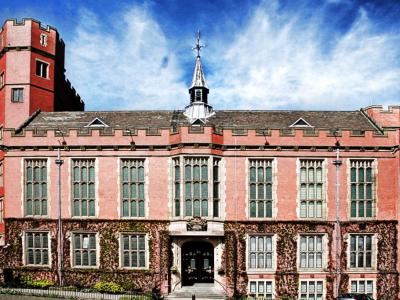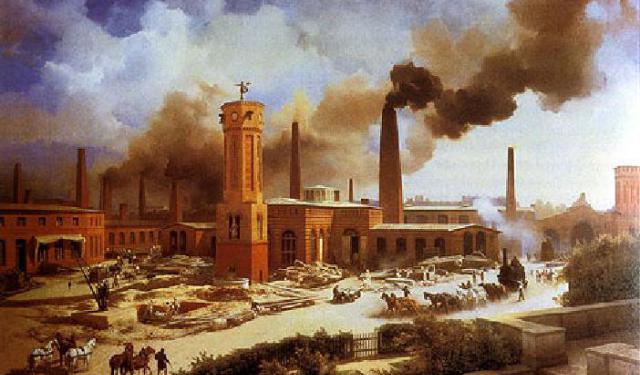Firth Court at University of Sheffield, Sheffield
Firth Court is an iconic Edwardian-style, red-brick building located on the Western Bank Campus of the University of Sheffield in Sheffield. Named after Mark Firth, a prominent Sheffield steel manufacturer who significantly contributed to the university's early development, Firth Court serves as the main administrative center for the university. It also houses the Departments of Molecular Biology and Biotechnology and Biomedical Science.
Constructed between 1903 and 1905, Firth Court was the first purpose-built facility for the University of Sheffield. It was designed by Edward Mitchel Gibbs, a Sheffield-born architect known for his contribution to the university's early architectural landscape. Originally named the Western Bank Building, Firth Court has played a pivotal role in the university's history and expansion.
Adjacent to Firth Court, near Weston Park, is the Rotunda-a two-story, Neo-Gothic-style octagonal chapter house designed by Gibbs. The Rotunda, built in mellow red-brick and sandstone, was opened in 1909 as the Edgar Allen Building, named after William Edgar Allen, a member of the University Council who funded its construction as a purpose-built library. The Rotunda served as the university's main library until the late 1950s when the Western Bank Library was established. It is currently used as the Registrar and Secretary's Office.
The Firth Court complex features a quadrangle formed by Firth Hall (formerly the Western Bank Building), North Block, and West Block, which were all completed by 1914 under Gibbs's direction. The final side of the quadrangle was completed with the addition of the Florey and Addison buildings in the late 1940s. During the Second World War, this quadrangle was adapted for use as an air raid shelter, adding a layer of historical significance to the building's legacy.
Firth Court is a distinguished landmark at the University of Sheffield, reflecting the university's rich history and the architectural vision of Edward Mitchel Gibbs, embodying the early 20th-century academic spirit and the philanthropic efforts that shaped its establishment.
Constructed between 1903 and 1905, Firth Court was the first purpose-built facility for the University of Sheffield. It was designed by Edward Mitchel Gibbs, a Sheffield-born architect known for his contribution to the university's early architectural landscape. Originally named the Western Bank Building, Firth Court has played a pivotal role in the university's history and expansion.
Adjacent to Firth Court, near Weston Park, is the Rotunda-a two-story, Neo-Gothic-style octagonal chapter house designed by Gibbs. The Rotunda, built in mellow red-brick and sandstone, was opened in 1909 as the Edgar Allen Building, named after William Edgar Allen, a member of the University Council who funded its construction as a purpose-built library. The Rotunda served as the university's main library until the late 1950s when the Western Bank Library was established. It is currently used as the Registrar and Secretary's Office.
The Firth Court complex features a quadrangle formed by Firth Hall (formerly the Western Bank Building), North Block, and West Block, which were all completed by 1914 under Gibbs's direction. The final side of the quadrangle was completed with the addition of the Florey and Addison buildings in the late 1940s. During the Second World War, this quadrangle was adapted for use as an air raid shelter, adding a layer of historical significance to the building's legacy.
Firth Court is a distinguished landmark at the University of Sheffield, reflecting the university's rich history and the architectural vision of Edward Mitchel Gibbs, embodying the early 20th-century academic spirit and the philanthropic efforts that shaped its establishment.
Want to visit this sight? Check out these Self-Guided Walking Tours in Sheffield. Alternatively, you can download the mobile app "GPSmyCity: Walks in 1K+ Cities" from Apple App Store or Google Play Store. The app turns your mobile device to a personal tour guide and it works offline, so no data plan is needed when traveling abroad.
Firth Court at University of Sheffield on Map
Sight Name: Firth Court at University of Sheffield
Sight Location: Sheffield, England (See walking tours in Sheffield)
Sight Type: Attraction/Landmark
Guide(s) Containing This Sight:
Sight Location: Sheffield, England (See walking tours in Sheffield)
Sight Type: Attraction/Landmark
Guide(s) Containing This Sight:
Walking Tours in Sheffield, England
Create Your Own Walk in Sheffield
Creating your own self-guided walk in Sheffield is easy and fun. Choose the city attractions that you want to see and a walk route map will be created just for you. You can even set your hotel as the start point of the walk.
Sheffield's Historical Buildings
Part of Sheffield’s great heritage is manifested in buildings. The presence of historical sites, some rather imposing like the Sheffield Town Hall and City Hall, presiding over the area, and the others like the Church of St Marie, somewhat hidden from view in a built-up neighbourhood, provides a colourful illustration of the city's glorious past.
Constructed over a time-span ranging from... view more
Tour Duration: 2 Hour(s)
Travel Distance: 2.9 Km or 1.8 Miles
Constructed over a time-span ranging from... view more
Tour Duration: 2 Hour(s)
Travel Distance: 2.9 Km or 1.8 Miles
Industrial Revolution Heritage Walking Tour
Steeped in history, the city of Sheffield is famed for its contribution to the Industrial Revolution, largely due to the development of stainless steel. Indeed, the “Steel City” of the United Kingdom, it was internationally renowned as a major hub of steel manufacturing during the 19th century. So much so, in fact, that George Orwell once famously referred to it as “the ugliest town in the... view more
Tour Duration: 2 Hour(s)
Travel Distance: 3.1 Km or 1.9 Miles
Tour Duration: 2 Hour(s)
Travel Distance: 3.1 Km or 1.9 Miles
Sheffield Introduction Walking Tour
Sheffield takes its name from the river Sheaf, which runs through the city. Field, of course, is an open space. The city sits at the confluence of the rivers Don and Sheaf. Don is the master stream. Its tributaries are the Loxely, Porter Brook, Rivelin, and Sheaf. There were settlements in this area as far back as 12,000 years ago.
After the Romans, settlements were Anglo-Saxon and Danish. With... view more
Tour Duration: 1 Hour(s)
Travel Distance: 1.7 Km or 1.1 Miles
After the Romans, settlements were Anglo-Saxon and Danish. With... view more
Tour Duration: 1 Hour(s)
Travel Distance: 1.7 Km or 1.1 Miles






